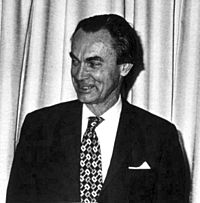Sune Bergström facts for kids
Quick facts for kids
Sune Bergström
|
|
|---|---|

Sune Bergström in April 1975.
|
|
| Born | 10 January 1916 |
| Died | 15 August 2004 (aged 88) Stockhom, Sweden
|
| Nationality | Swedish |
| Known for | Prostaglandins |
| Awards | Nobel Prize in Physiology or Medicine, Louisa Gross Horwitz Prize |
| Scientific career | |
| Fields | Biochemistry |
Karl Sune Detlof Bergström (born January 10, 1916 – died August 15, 2004) was a famous Swedish scientist. He was a biochemist, which means he studied the chemistry of living things. Bergström is best known for his important discoveries about special substances in our bodies called prostaglandins.
His work helped us understand how these substances affect our health. For his amazing discoveries, he won the Nobel Prize in Physiology or Medicine in 1982. He shared this big award with two other scientists, Bengt I. Samuelsson and John R. Vane.
Who Was Sune Bergström?
Sune Bergström was born in Stockholm, Sweden. From a young age, he was very interested in science. He grew up to become a leading expert in biochemistry. This field explores the chemical processes happening inside living organisms.
He spent many years studying at the Karolinska Institutet in Stockholm. This is a very famous medical university. He even became the head of the medical department there. Later, in 1969, he became the Rector, which is like being the president of the university.
Discovering Prostaglandins
Bergström's most important work was on a group of chemical compounds called lipids. Lipids are like fats and oils found in our bodies. He focused on a specific type of lipid called prostaglandins.
Prostaglandins are powerful substances that act like hormones. They are found in almost all tissues and organs. They play a role in many body functions. For example, they can cause pain, inflammation, and even help control blood pressure.
Before Bergström's work, scientists knew very little about prostaglandins. He was one of the first to isolate them. To "isolate" means to separate them from other substances. He then studied their chemical structure. This helped scientists understand how they work.
His research showed how prostaglandins are made in the body. It also showed how they affect different cells and organs. This was a huge step forward in medicine.
Winning the Nobel Prize
In 1982, Sune Bergström received the Nobel Prize in Physiology or Medicine. He shared the prize with his colleague Bengt I. Samuelsson and British scientist John R. Vane. They were honored for their discoveries about prostaglandins and related substances.
Their work opened up new ways to treat many diseases. For example, it led to the development of medicines that reduce pain and inflammation. These medicines are used for conditions like arthritis. Their discoveries also helped in understanding blood clotting and allergies.
The Nobel Prize is one of the highest honors a scientist can receive. It showed how important Bergström's research was for human health.
See also
 In Spanish: Sune Karl Bergström para niños
In Spanish: Sune Karl Bergström para niños

